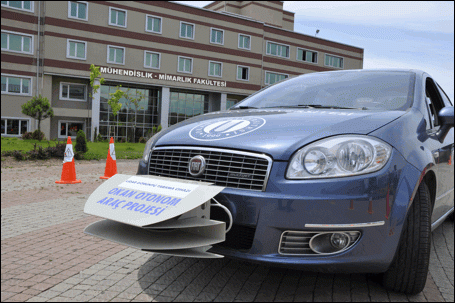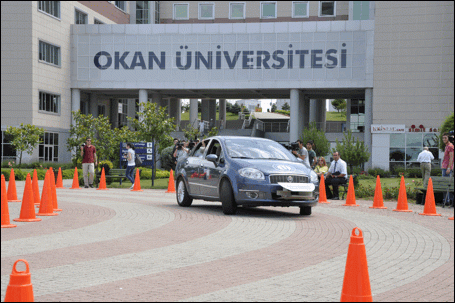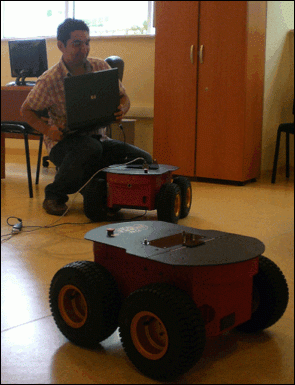
Recently, an autonomous vehicle development project was started at OKAN University. This project is being conducted at the Transportation Technologies and Intelligent Automotive Systems Application and Research Center (TTIS) at Okan University. The vehicle under development is shown in the picture above. This vehicle is being developed so that it can drive on the road by itself. Using the LIDAR in front of it, it can detect the distances of the objects in front of it. The LIDAR works like a radar. Using the times it takes for the laser rays to travel to the objects and come back, the distances of the objects from the vehicle are calculated. Using this information, the vehicle will drive itself. The collection and analysis of this information and having the vehicle drive itself are parts of the research project. Furthermore, the steering system has been transformed into an electric one by Okan University Researchers. As seen in the picture below the vehicle driving itself was shown to the press on June 30 2011.

It is suspected that autonomous vehicles will improve safety on the road. It is not possible for an autonomous vehicle to be sleepy unless it is broken. Furthermore, it is known that computers can respond much faster than humans. Therefore, if you are cut off by another vehicle an autonomous vehicle will hit the brakes faster. Because of the capability of vehicles to brake faster, vehicles can travel closer to each other on the highway. Thus, more vehicles can safely fit on the highway. Furthermore, if trucks are fit close to each other on the highway, fuel consumption can be decreased. This is because, for vehicles that follow each other closely, the vehicle in front will pull the vehicle behind it. Race car drivers and even race bicyclists use this method to consume less energy.
In the first stage of the project at Okan University, the vehicle will travel on roads that have no other vehicles. Afterwards, the vehicle will be tested on roads that are similar to highways. The final stage is to develop a vehicle that will travel on roads with regular traffic. Traveling in the city is a much more difficult problem. There are pedestrians that can jump on the road and there are traffic lights to be followed. Of course, a lot of research must be done to reach this level.
Another area of research within the autonomous vehicle project is vehicle to vehicle and vehicle to infrastructure communication. This research can also be used for vehicles that are not autonomous. For example, if a broken down vehicle that cannot be seen is at the end of a turn and this vehicle warns you, you can slow down. A possible useful system for Istanbul is a system that automatically warns you about traffic jams ahead and directs you towards another path. The methodology of how this communication will be done is a research topic at Okan University.
Interaction of several autonomous vehicles is another area of research at Okan University. For experimentation on this interaction, the two off-road robots shown in the picture below have been purchased. Currently, the sensors for these robots are being developed.

The team headed by Prof. Dr. Nejat Tuncay, the Dean of the Engineering and Architecture Faculty, consists of Okan University associates Prof. Dr. Tevfik Akgün, Prof. Dr. Levent Güvenç, Assoc. Prof. Dr. Bilin Güvenç, Asst. Prof. Dr. Başar Özkan, Asst. Prof. Barış Öztürk, Asst. Prof. Burak Kelleci, Lecturer Zeynel Koç, Res. Asst. Şafak Güner and Res. Asst. Muharrem Yıldız. Additionally, Ohio State Professor Dr. Ümit Özgüner, known worldwide for his work on autonomous vehicles, is part of the project as the coordinator of TTIS. Asst. Prof. Dr. Tankut Acarman from Galatasaray University, and Asst. Prof. Dr. Özgür Üstün and Dr. Murat Yılmaz from İTÜ (Istanbul Technical University) are also working in this project. Nejat Tuncay worked on the Tofaş Doblo Project, the first hybrid vehicle developed in Turkey, at the TÜBİTAK Marmara Research Center with Jan Nahum. Tofaş R&D is giving support to the project and has provided the FIAT automobile shown in the first picture.
The Okan Autonomous Vehicle Project consists of several sub-projects. These are:
Development of the computer system: The computer system must be developed according to the needs of the above sub-projects. Work in this area is also underway.